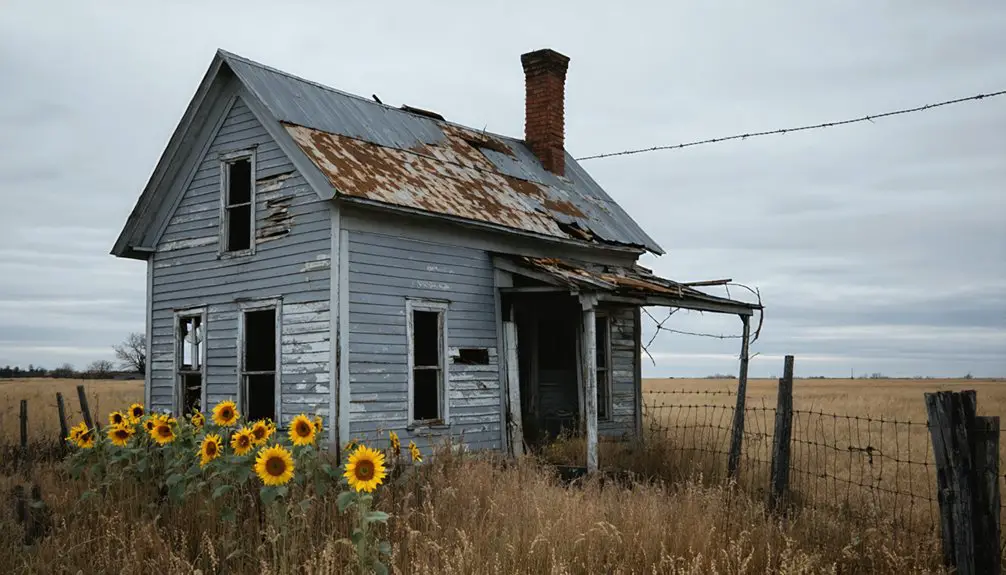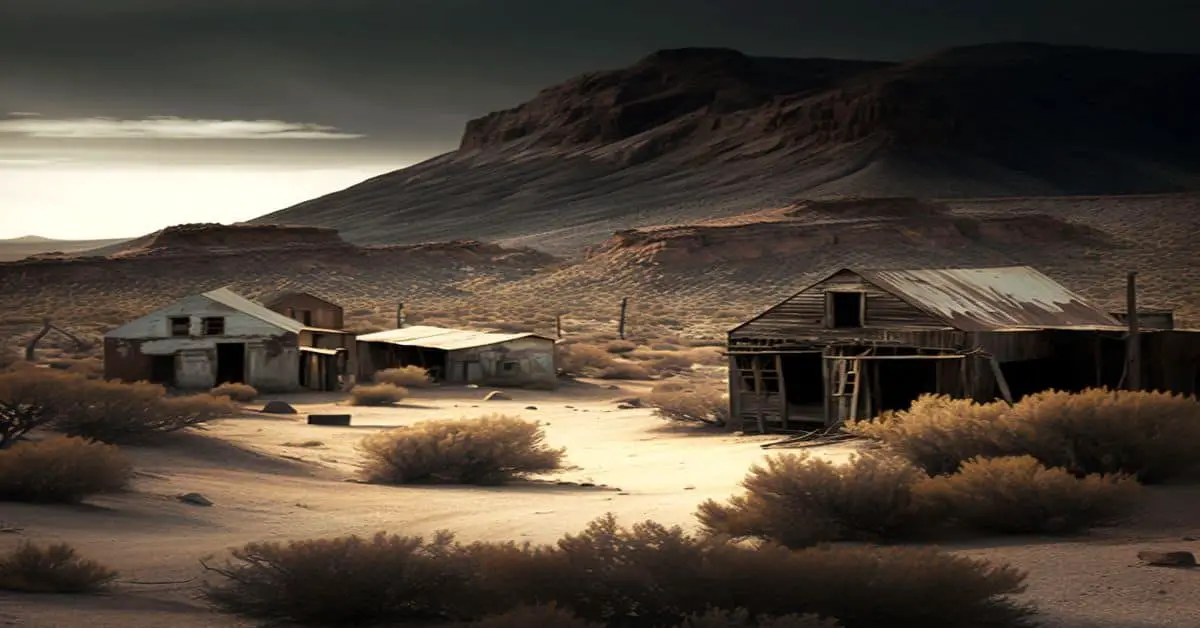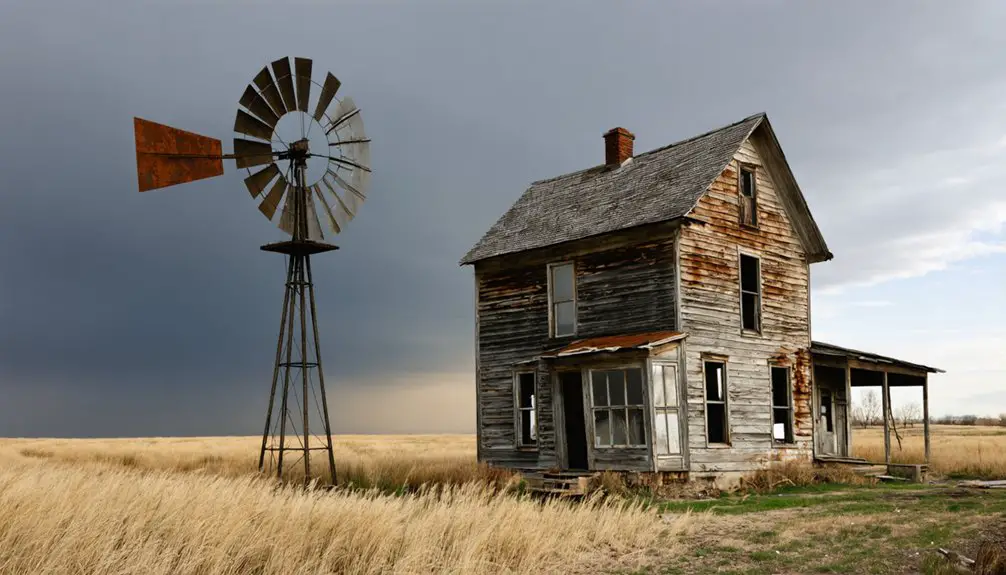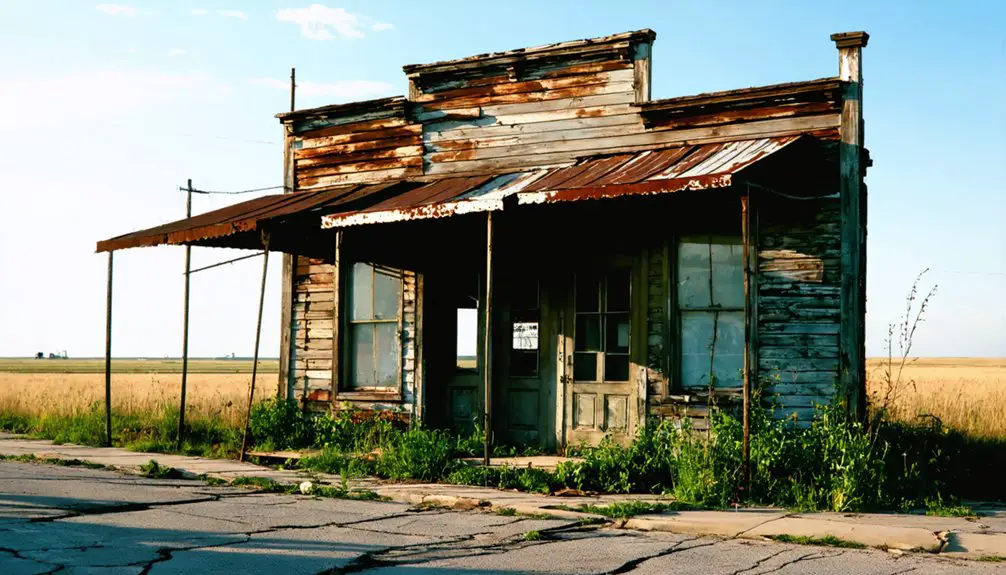You’ll find Tate, Nebraska’s ghost town remains in southeastern Nebraska, where it emerged during the Kansas City and Northwestern Railroad’s expansion in 1891. The settlement reached its peak of 100 residents by 1910, featuring sod homes and resilient pioneer families who faced harsh prairie conditions. After the railroad ceased operations in 1920, Tate’s decline accelerated until its abandonment in 1950. The town’s crumbling structures and rich folklore hold countless stories of frontier life.
Key Takeaways
- Founded in 1891 due to railroad development, Tate reached its peak population of 100 residents in 1910 before declining.
- The town’s fate was sealed when railroad service ceased in 1920, eliminating vital transportation links for the community.
- Remnants include an old hotel and former mayor’s house, though most structures are deteriorated and unsafe to explore.
- Local supernatural folklore includes sightings of “Faceless Fred” and legends of the “Salt Witch” near the town’s ruins.
- Visitors need 4WD vehicles to access the site between March and October, as there are no paved roads or cell service.
The Rise and Fall of a Prairie Settlement
While many Midwestern railroad towns emerged in the late 19th century, Tate, Nebraska carved out its own brief but distinct chapter in America’s westward expansion.
You’ll find Tate’s origins tied directly to the Kansas City and Northwestern railroads, which brought life to this prairie settlement on December 9, 1891.
Named after a railroad director, the town’s significance centered on its crucial rail connection that linked settlers to broader trade networks. The community reached its peak with 100 residents in 1910. Like many frontier settlements of its era, Tate emerged during a time when towns like St. Deroin ferryboat hub helped establish vital transportation routes through the region.
Life on the Nebraska Frontier
Life on Nebraska’s frontier tested your resolve daily as you’d construct a home from thick sod blocks, carefully layering them to keep out harsh prairie winds and rain.
You’d face the constant struggle of maintaining a watertight roof, often patching leaks with yellow clay after heavy storms battered your humble dwelling. Vermin and snakes would frequently make unwelcome appearances through gaps in the sod walls, making daily life even more challenging.
Your daily survival depended on adapting to extreme weather swings while managing scarce resources, from precious timber to water, all while staying alert for potential conflicts with cattle ranchers who opposed the fencing of open grazing lands. Many immigrant settlers from Germany and Scandinavia established ethnic colonies in these challenging frontier conditions.
Pioneer Daily Routines
Settling into daily routines on Nebraska’s frontier demanded extraordinary resilience from pioneers who faced harsh environmental challenges in the 1800s.
You’d start your day gathering fuel for your sod house’s stove, collecting whatever you could find – wood, buffalo chips, or sunflower stalks. Pioneer chores revolved around maintaining your homestead and ensuring survival through harsh seasons. You’d tend to crops like corn and wheat, while your children helped gather wild fruits and vegetables from the garden. Many homesteaders built simple sod homes due to the severe lack of timber in the region. Women played a crucial role in homesteading life, with female homesteaders making up nearly 25% of land claims.
During winter months, you’d rely heavily on preserved foods and stored supplies.
Communal gatherings provided essential support, as neighbors helped each other through crises and extreme weather. You’d join forces for activities like quilting or seasonal fieldwork, strengthening the bonds that made frontier survival possible.
Hardships of Settlement
Despite promises of prosperity on Nebraska’s frontier during the 1870s and 1880s, settlers faced brutal environmental and economic challenges that tested their resolve daily.
You’d find your settler resilience pushed to the limit as harsh prairie winds, extreme temperatures, and devastating grasshopper plagues between 1874-1877 destroyed crucial crops. Your agricultural innovation became essential for survival, as you’d need to adapt to poor soil conditions and build sod houses for shelter. The economic panic of 1857 had already taught early settlers they couldn’t rely solely on land speculation for survival.
If disease, isolation, or wildlife dangers didn’t break your spirit, the economic hardships might. You’d struggle with fluctuating land prices, limited market access, and crushing debt.
When drought struck, your crops failed, and commodity prices plummeted in the 1890s, many of your neighbors abandoned their claims, leaving ghost towns like Tate behind.
Agricultural Heritage and Economic Changes
While many Nebraskan towns flourished through agricultural prosperity in the late 1800s, Tate’s farming community faced persistent challenges that shaped its eventual decline.
Despite regional agricultural success in 1800s Nebraska, persistent hardships gradually eroded the foundations of Tate’s once-vibrant farming community.
Like typical towns spaced six miles apart, Tate relied on its strategic location to serve local farmers, but the community struggled to maintain its foothold. You’d have found local farmers struggling with crop sustainability as they worked the soil with horse-drawn plows, growing corn, wheat, and oats. Their economic resilience was tested by volatile crop prices, especially during the market downturns of the 1880s and 1890s.
When mechanization arrived in the early 1900s, many of Tate’s small-scale farmers couldn’t afford the new equipment. Without strong railroad connections to distant markets, they watched as neighboring towns drew away commerce and residents. Like many communities during the Financial Panic of 1857, Tate’s growth was severely limited by economic instability and lack of capital investment.
The shift toward larger commercial farms dealt the final blow, as consolidation gradually emptied the countryside of the family farms that had once sustained Tate’s liveliness.
Railroad’s Impact on Tate’s Destiny
The arrival of the Kansas City and Northwestern Railroad in 1891 marked Tate’s official beginning, as the town sprang up around its newly established station.
You’ll find that railroad connections defined Tate’s entire existence, from its birth to its ultimate demise. As the town’s economic lifeline, the railroad enabled local businesses to thrive and helped the population grow to about 100 residents by 1910. Much like how the first Underground Railroad station in Nebraska Territory was established at the Dorrington farm in Falls City in 1857, Tate’s railroad station became a crucial transportation hub for the region.
When railroad service ceased in 1920, Tate’s fate was sealed. Without the essential transportation link that connected the town to larger markets, residents couldn’t sustain their livelihoods.
Historical Buildings and Remaining Structures
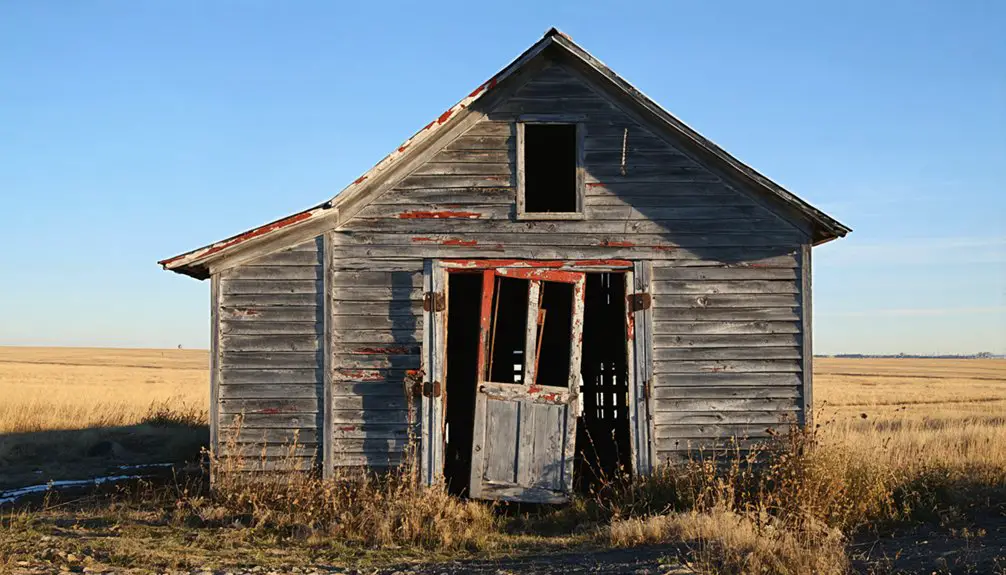
Standing as silent sentinels to Tate’s bygone era, two weathered structures remain visible across Nebraska’s rural landscape: an old hotel and the former mayor’s house.
These remnants of historical architecture showcase the town’s brief but significant period from 1891 to 1920, when railroad activity brought life to this settlement.
The railroad era’s fleeting prosperity echoes through Tate’s architectural legacy, marking a transformative chapter in Nebraska’s settlement history.
You’ll find the buildings reflect early 20th-century construction techniques, with locally sourced wood and brick typical of Nebraska’s railroad towns.
While architectural decay has taken its toll since the 1950s, when the last residents departed, you can still discern the original forms that once served travelers and civic leadership.
Without active preservation efforts, these structures continue their slow transformation under harsh Nebraska winters and scorching summers, offering you a rare glimpse into small-town railroad life.
Tales and Legends From the Ghost Town
Beyond the physical remnants of Tate’s historic buildings, supernatural tales and haunting legends have shaped local folklore since the town’s abandonment in 1950.
You’ll hear stories of ghostly sightings near the old theater, where witnesses report mysterious lights and props moving on their own after dark. Local folklore speaks of a phantom known as Faceless Fred, who’s said to haunt the site of a former well-turned-restaurant, where his wife allegedly murdered him.
Native American influences add depth to these supernatural accounts, with Pawnee legends warning of ancient spirits tied to the nearby salt flats.
If you visit at night, you might encounter the infamous Salt Witch, whose spectral form is said to guard a sealed dark force beneath a distinctive salt column.
Natural Surroundings and Geographic Features
As you explore Tate’s natural setting, you’ll find yourself amid the classic Great Plains landscape of southeastern Nebraska, where gently rolling prairie grasslands stretch toward the horizon.
The semi-arid terrain features native grasses and scattered drought-resistant shrubs, shaped by the region’s continental climate of hot summers and snowy winters.
You’ll notice the area’s limited water features, unlike other Nebraska ghost towns situated near rivers, which contributed to Tate’s agricultural challenges and eventual abandonment.
Prairie Grasslands and Valleys
The diverse prairie grasslands surrounding Tate showcase Nebraska’s rich ecological tapestry, from tallgrass prairies in the east to shortgrass prairies in the west.
You’ll find yourself in a transitional area where mixed grass prairie ecosystems meet the rolling hills of the Central Nebraska Loess Plains, with well-drained silty soils supporting remarkable grassland biodiversity.
As you explore the landscape, you’ll discover steep valleys carved through the dissected plains, where oak-hickory forests line the drainage areas.
The region’s deep loess deposits, reaching over 60 feet thick near the Sandhills, create a distinct terrain of undulating hills.
This dynamic environment represents one of Nebraska’s most intact prairie regions, where native grasses still stabilize the soil and support diverse wildlife communities.
Local Water Sources
While exploring Tate’s water landscape, you’ll find yourself in a region shaped by the Little Nemaha Creek and numerous smaller streams that weave through Otoe County’s rolling terrain.
You’re within the vast Ogallala Aquifer system, where historical streams and drainage systems have carved paths through the prairie. Though you won’t spot the Missouri River directly, its influence extends to the area’s water patterns.
You’ll notice signs of past water quality challenges, as groundwater issues and mineral-rich aquifers affected early settlers’ water access.
Surface runoff from the region’s 30-35 inches of annual rainfall contributes to aquifer replenishment, feeding scattered wetland habitats.
These smaller water features, including ephemeral ponds and marshy areas, once supported local wildlife and settlers alike, despite their susceptibility to drought periods.
Weather-Shaped Terrain
Standing at the center of Tate’s abandoned grounds, you’ll witness a landscape shaped by Nebraska’s dramatic seasonal extremes. The flat to gently rolling terrain bears the marks of harsh weather patterns, from winter’s deep freeze to summer’s scorching heat.
You’ll notice dry, compacted soil stretching across the plain, cracked from intense summer droughts and scarce rainfall. In winter, snow blankets the ground, while strong winds sculpt the snow into varying depths.
These seasonal cycles impact terrain stability through continuous freeze-thaw actions. Wind-driven erosion has gradually reshaped the surface since Tate’s abandonment in the 1920s, while natural vegetation has slowly reclaimed old pathways and building sites.
Without human intervention, the ghost town’s landscape continues its transformation under nature’s persistent influence.
Photography and Documentation Through Time
Since its establishment in December 1891, photographers have documented Tate’s evolution from a bustling railroad town to an abandoned ghost town through various visual mediums.
Historical photography first captured the town’s growth around the Kansas City and Northwestern railroads, with images of the station, commercial buildings, and a community that peaked at 100 residents in 1910.
After 1920, the visual storytelling shifted to chronicle Tate’s decline, as photographers recorded abandoned structures and architectural decay.
Today, you’ll find digital photographers and urban explorers sharing their discoveries through online platforms, while video documentarians provide immersive tours of the ruins.
Archives continue to preserve Tate’s visual history through a combination of historic plat maps, archival photos, and modern digital documentation.
Preservation Efforts and Historical Records
Although preservation efforts for Tate remain limited, the town’s historical records paint a picture of its brief but significant presence in Nebraska’s past.
While the town faces preservation challenges, you’ll find its legacy documented through various historical records, from plat books to postal service archives spanning 1891-1920.
Here’s what makes Tate’s historical significance endure:
- Census records reveal its peak population of 100 residents in 1910
- Local cemeteries preserve the names and stories of former inhabitants
- County historical societies maintain regional archives detailing Tate’s role
- Railroad documentation chronicles the town’s rise and eventual decline
Unlike movie-style ghost towns, Tate’s story reflects the genuine evolution of Nebraska’s landscape, preserved primarily through documentation rather than physical restoration.
Visiting the Abandoned Town Today
Today’s visitors to Tate will find a markedly different scene from the bustling railroad town documented in historical records. Your ghost town exploration will reveal just two main structures still standing – an old hotel and the former mayor’s house, both weathered by time and Nebraska’s harsh climate.
You’ll need a 4WD vehicle to access this remote site, as rough terrain and unpaved roads make conventional transportation impractical.
For the safest experience, plan your visit between March and October, avoiding the winter months when snow and severe cold can make the journey treacherous.
When exploring the abandoned structures, bring plenty of water, emergency supplies, and exercise caution around deteriorating buildings.
There’s no cell service, so let someone know your plans before venturing into this isolated piece of railroad history.
Frequently Asked Questions
Are There Any Burial Sites or Cemeteries Near Tate?
While you’ll find burial grounds near Table Rock and Ogallala, with cemetery history dating to the 1800s, Tate’s exact burial sites remain mysterious, though pioneer-era graves likely exist nearby.
What Caused the Last Resident to Finally Leave Tate?
You’ll find that severe economic decline following the railroad’s departure, combined with harsh weather conditions and lack of basic services, forced the final resident to abandon their isolated homestead by the 1950s.
Did Any Famous People or Notable Events Originate in Tate?
Like many quiet prairie settlements, you won’t find any famous residents or notable historic events from Tate. The town’s brief 29-year existence only left behind railroad records and two buildings.
Were There Any Schools or Churches Established in Tate?
You’ll find Tate’s history includes one documented church, but there’s no clear evidence of schools. The town’s education legacy likely relied on neighboring communities during its brief 1891-1920 existence.
What Indigenous Tribes Originally Inhabited the Area Where Tate Was Built?
The Pawnee Tribe primarily inhabited this region, though you’d have found the Ponca and Omaha Tribes moving through periodically. The Pawnee established permanent villages along waterways before European-American settlement began.
References
- https://www.nebraskalife.com/blog/post/saint-deroin-ghost-town
- https://history.nebraska.gov/the-headless-ghost-of-redington-nebraska/
- https://www.youtube.com/watch?v=q1Bww945Vhc
- https://www.legendsofamerica.com/grant-county-nebraska/
- https://www.youtube.com/watch?v=Iw21dwaXkck
- https://www.ghosttowns.com/states/ne/tate.html
- http://www.eyewitnesstohistory.com/butcher.htm
- https://en.wikipedia.org/wiki/History_of_Nebraska
- https://www.britannica.com/place/Nebraska-state/History
- https://www.nebraskalife.com/blog/post/frontier-matriarchs
